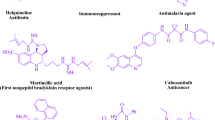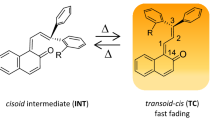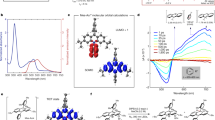Abstract
ANOMALOUS colour changes exhibited by methylene blue (Fig. 1, I) in organic media containing amines in the dark have been reported and rationalized in various ways1–3. These observations are of interest in connexion with studies of the photochemical reduction of I by amines1, the use of I in photosensitized autoxidation of amines4,5 and the investigation of dye-amine catalyst systems for photopolymerization6. We have encountered similar events in our own work in these areas and have identified the cause as base-catalysed self-oxidation7,8 or disproportionation of compound I followed by hydrolysis of the oxidized species VII to the demethylated dye II which is pale red in basic solution. This provides a general explanation for the various observations referred to.
This is a preview of subscription content, access via your institution
Access options
Subscribe to this journal
Receive 51 print issues and online access
$199.00 per year
only $3.90 per issue
Buy this article
- Purchase on Springer Link
- Instant access to full article PDF
Prices may be subject to local taxes which are calculated during checkout
Similar content being viewed by others
References
McKay, R. B., Nature, 210, 296 (1966).
Yushina, V. V., and Nikolaev, L. A., Russ. J. Phys. Chem., 37, 1226 (1963).
Obata, H., and Koizumi, M., Bull. Chem. Soc. Japan, 30, 136, 142 (1957).
Weil, L., and Maher, J., Arch. Biochem., 29, 241 (1950).
Schenk, G. O., Angew. Chem., 69, 579 (1957).
Oster, G., and Yang, N-L., Chem. Revs., 68, 125 (1968).
Bernthsen, A., Ann., 230, 73 (1885); Ber., 39, 1804 (1906).
Holmes, W. C., and Snyder, E. F., Stain Tech., 4, 7 (1929).
Gnehm, R., and Kaufler, F., Ber., 39, 1016 (1906).
Kehrmann, F., and Schaposchnikoff, W., Ber., 33, 3291 (1900).
Layer, R. W., Chem. Revs., 63, 487 (1963).
Barnes, K. K., and Mann, C. K., J. Org. Chem., 32, 1474 (1967).
Smith, P. A. S., and Loeppky, R. N., J. Amer. Chem. Soc., 89, 1147 (1967).
Bacon, R. G. R., and Stewart, D., J. Chem. Soc. (C), 1384, 1388 (1966).
Kehrmann, F., Ber., 39, 1402 (1906).
Usui, Y., Obata, H., and Koizumi, M., Bull. Chem. Soc. Japan, 34, 1049 (1961).
Koizumi, M., Obata, H., and Hayashi, S., Bull. Chem. Soc. Japan, 37, 108 (1964).
Matsumoto, S., Bull. Chem. Soc. Japan, 37, 499 (1964).
Usui, Y., Bull. Chem. Soc. Japan, 38, 206 (1965).
Holmström, B., Arkiv Kemi, 22, 329 (1964).
Lindqvist, L., Arkiv Kemi, 16, 79 (1960).
Author information
Authors and Affiliations
Rights and permissions
About this article
Cite this article
SCHAEFER, F., ZIMMERMANN, W. Self-oxidation of Methylene Blue. Nature 220, 66–67 (1968). https://doi.org/10.1038/220066a0
Received:
Revised:
Issue Date:
DOI: https://doi.org/10.1038/220066a0
Comments
By submitting a comment you agree to abide by our Terms and Community Guidelines. If you find something abusive or that does not comply with our terms or guidelines please flag it as inappropriate.



